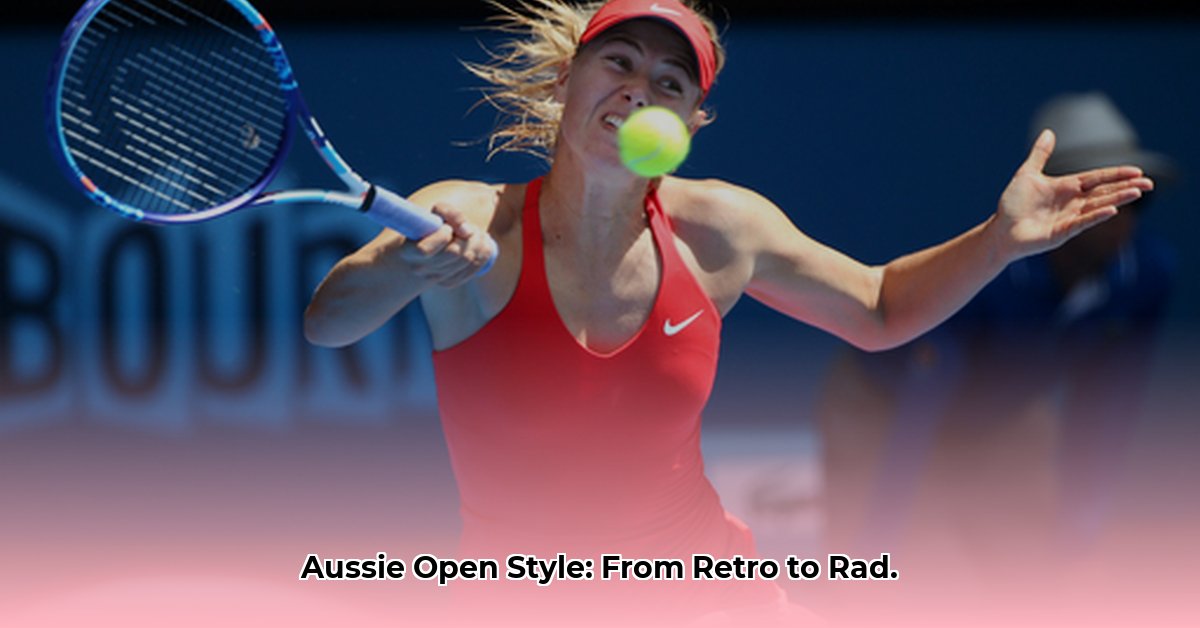Courtside Couture: From Classic Whites to Daring Designs
Tennis fashion at the Australian Open has undergone a dramatic transformation throughout the decades, mirroring broader cultural trends and technological advancements. From the elegant simplicity of all-white ensembles to the vibrant explosion of color and personalized style we see today, the evolution of on-court attire reflects the changing spirit of the game and the athletes who play it. This chronological timeline, combined with key trend summaries and rich visuals, explores the most iconic looks, influential players, and unforgettable fashion moments that have shaped Australian Open style.
1920-1980s: Elegance and Tradition: Serving Up Simplicity
The early decades of the Australian Open were marked by a sense of timeless elegance and adherence to tradition. Imagine crisp white dresses and pleated skirts, accented with cable-knit cardigans and polo shirts—a look reminiscent of Wimbledon’s classic aesthetic. Practicality and comfort were paramount, given the demanding nature of the sport and the Melbourne sun. This era emphasized functionality over flamboyance, laying the groundwork for the stylistic revolutions to come.
- Key Trends: All-white attire, classic silhouettes, natural fabrics like cotton and wool.
- Iconic Players: While specific player outfits are less documented from this period, it was characterized by a collective adherence to traditional tennis attire.
(Insert image gallery or slideshow showcasing early Australian Open fashion)
1990s: The Rise of Casual Cool: Game, Set, and Streetwear
The 1990s ushered in a new era of casual cool, challenging the longstanding tradition of all-white tennis attire. Streetwear influences began to permeate the courts, led by the iconic Andre Agassi. His vibrant neon ensembles, bandanas, and denim shorts were a bold departure from the norm, capturing the rebellious spirit of the decade. Pat Rafter’s relaxed striped polos further solidified the move towards casual comfort, creating a distinct Australian Open aesthetic.
- Key Trends: Neon colors, oversized silhouettes, streetwear influences, the introduction of stretch polyester.
- Iconic Players: Andre Agassi, Pat Rafter
(Include image of Agassi in neon and Rafter in striped polo)
Late 1990s/Early 2000s: Logos and Fitted Silhouettes: Branding the Baseline
As the millennium approached, logos took center stage. Fitted attire made from stretch polyester became de rigueur, highlighting both the athletes’ physiques and the brands they represented. Anna Kournikova’s trendy Adidas ensembles and Martina Hingis’ signature style epitomized this era, showcasing the increasing intersection of sport, style, and marketing.
- Key Trends: Fitted silhouettes, prominent logos, stretch polyester, athletic branding.
- Iconic Players: Anna Kournikova, Martina Hingis
(Insert image of Kournikova in Adidas and Hingis on court)
2000s: The Power of Personality: Aceing Individuality
The 2000s saw the rise of the tennis fashion icon. Venus and Serena Williams, along with Maria Sharapova, brought a powerful dose of individual flair to the court. Intricate dresses, sleek bodysuits, and daring crop tops—often embellished with eye-catching details—became statements of self-expression. This era celebrated individuality, transforming the Australian Open into a platform for personal style.
- Key Trends: Bold designs, individual flair, intricate embellishments, daring cuts and silhouettes, color blocking.
- Iconic Players: Venus and Serena Williams, Maria Sharapova
(Include images of the Williams sisters and Sharapova in their iconic 2000s outfits)
2010s – 2020s: Pushing Boundaries and Embracing Sustainability: A Sustainable Serve
From Roger Federer’s sleek Uniqlo collaborations to Nick Kyrgios’ rebellious basketball singlets, the 2010s celebrated pushing boundaries. Serena Williams continued to make headlines with her powerful and sometimes controversial fashion choices, including the iconic catsuit. The 2020s introduced a focus on sustainability, with designers like Cassie Byrnes pioneering eco-conscious performance wear. Destanee Aiava’s embrace of vintage styles added another layer of diversity, signaling a potential return to classic aesthetics.
- Key Trends: Diverse styles, pushing boundaries, self-expression, sustainability, vintage inspiration, technological innovation in fabrics.
- Iconic Players: Serena Williams, Nick Kyrgios, Destanee Aiava, Roger Federer
(Include images of Serena’s catsuit, Kyrgios in a singlet, Aiava in vintage, and Federer in Uniqlo.)
The Future of Australian Open Fashion: Advantage, Innovation
What does the future hold for Australian Open fashion? Will we see a resurgence of classic elegance, or will technology lead to even more innovative and personalized designs? Perhaps a blend of both. As the worlds of sport, fashion, and technology continue to intertwine, the Australian Open is likely to remain at the forefront of on-court style, providing a platform for athletes and designers to express themselves and push the boundaries of athletic wear. The only certainty is that it will continue to be as dynamic and captivating as the game itself.
- Wellness Fair Ideas for Work to Boost Employee Wellbeing - December 15, 2025
- Affordable Employee Wellness Fair Ideas for Any Budget - December 14, 2025
- Employee Wellness Programs Strategically Benefit Employee Health And Retention - December 13, 2025
















